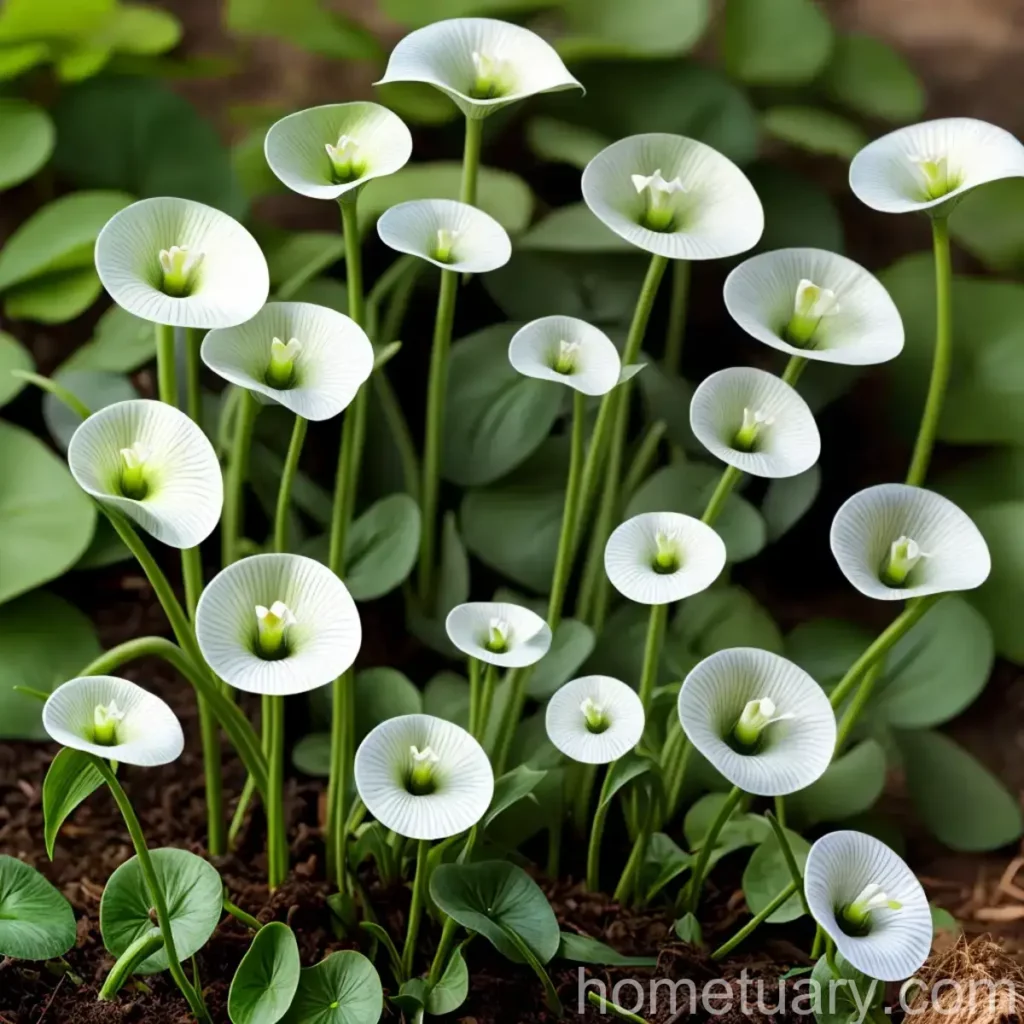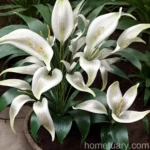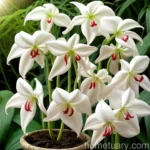What is Mouse Plant (Arisarum proboscideum)?
Introduction to Mouse Plant
Mouse plant (Arisarum proboscideum) is a unique and intriguing species that captures the attention of botanists and gardening enthusiasts alike. This charming plant, also known as the “Lords and Ladies,” belongs to the Araceae family and is native to the Mediterranean region.
The Arisarum genus encompasses several species, but Arisarum proboscideum stands out for its distinctive mouse-shaped inflorescence. This uncommon feature has earned it the common name “mouse plant,” which accurately describes the plant’s small, tail-like spadix that resembles a mouse’s tail.
Mouse plant’s remarkable appearance, coupled with its undemanding nature, makes it a delightful addition to various indoor and outdoor settings. Understanding its growth requirements, care tips, and unique characteristics can help cultivate a thriving mouse plant and appreciate its ornamental value.
Key Takeaways – Mouse Plant (Arisarum proboscideum)
Before delving into the intricacies of mouse plant care, it’s essential to highlight key takeaways about Arisarum proboscideum. This section provides a quick overview of its characteristics, growth requirements, and potential uses.
Mouse Plant (Arisarum proboscideum) at a Glance:
- Scientific Name: Arisarum proboscideum
- Common Names: Mouse plant, Jack-in-the-Pulpit, Lords and Ladies
- Family: Araceae
- Native Habitat: Mediterranean region
- Distinctive Feature: Mouse-shaped inflorescence
- Growth Preference: Partial to full shade, moist soil
- Uses: Ornamental plant in gardens and indoor settings
- Special Attribute: Unique, captivating appearance
Now that we’ve established an overview of mouse plant, let’s delve into each aspect in detail to understand how to care for and appreciate this enchanting plant.
Culture
Mouse Plant (Arisarum proboscideum) Culture
Water:
Mouse plant thrives in consistently moist soil, making it well-suited for shaded gardens and woodland settings. Regular watering is crucial, especially during dry periods, to maintain the soil’s moisture levels. However, it’s essential to avoid waterlogging, as excessively wet conditions can lead to root rot and other issues.
Sunlight:
In its natural habitat, mouse plant grows beneath the canopy of trees, receiving filtered light or partial shade. When cultivated in gardens or containers, it is essential to replicate these light conditions. An ideal location for mouse plants includes areas with dappled sunlight or partial shade. Excessive exposure to direct sunlight can scorch the delicate foliage, leading to stress and reduced vigor.
Fertilizer:
While mouse plants are not heavy feeders, providing a balanced, all-purpose fertilizer during the growing season can promote healthy foliage and flowering. A water-soluble fertilizer, diluted to half or quarter strength, can be applied every 4-6 weeks during the active growth period. Fertilization should be reduced or withheld during the plant’s dormant phase.
Soil:
Optimal soil conditions for mouse plant include rich, well-draining, and slightly acidic to neutral soil. A blend of loamy soil, organic matter, and perlite or sand can create a suitable growing medium. Maintaining adequate moisture retention without compromising drainage is essential for mouse plant cultivation.
Pruning:
Minimal pruning is typically required for mouse plants. Removing any yellowing or damaged leaves, as well as spent inflorescences, can enhance the plant’s appearance and prevent disease spread. Pruning should be undertaken with sharp, sterilized tools to minimize stress and promote quick healing of pruning wounds.
Uses
Mouse Plant (Arisarum proboscideum) Uses
Mouse plant’s ornamental value and adaptability make it a versatile species with several potential uses. Whether as a charming addition to shaded gardens or an intriguing specimen for indoor displays, there are various ways to incorporate mouse plant into diverse settings.
Garden Uses:
- Shaded Gardens: Mouse plant flourishes in shaded or partially shaded areas, adding delicate elegance and visual interest to woodland gardens, shaded borders, or understorey plantings.
- Rock Gardens: Its compact growth habit and attractive foliage make it a suitable candidate for rock gardens with partial shade, where it can thrive alongside other shade-tolerant species.
- Containers and Planters: Mouse plants can be cultivated in containers, hanging baskets, or decorative planters, offering an enchanting accent for patios, balconies, and indoor settings.
Indoor Gardening:
- Houseplant: With its moderate growth rate and adaptability to low light conditions, mouse plant can serve as an eye-catching houseplant, enhancing indoor spaces with its unique charm.
- Terrarium Addition: Its compact size and low-maintenance requirements make mouse plant an excellent choice for terrariums or enclosed glass containers, creating miniature woodland landscapes.
Water
Mouse Plant (Arisarum proboscideum) Watering Needs
Proper watering is crucial for the health and vitality of mouse plants, given their preference for consistently moist soil. Understanding the plant’s watering needs and implementing appropriate techniques are essential for promoting robust growth and preventing moisture-related issues.
Optimal Watering Practices for Mouse Plants:
- Consistent Moisture: Maintain consistent soil moisture without allowing the soil to become waterlogged. Regular, moderate watering during dry periods is vital, especially in shaded or indoor settings.
- Avoid Overwatering: While mouse plants require moist soil, it’s important to prevent overwatering, as this can lead to root rot, fungal diseases, and compromised root health.
- Check Soil Moisture: Monitor the soil moisture levels regularly by inserting a finger into the soil. Water the plant when the top inch of the soil feels dry, ensuring thorough but controlled watering.
Watering Considerations for Containers:
- Drainage: Ensure that the containers have drainage holes to prevent water accumulation. Allow excess water to drain freely to avoid waterlogging, which can adversely affect the plant’s root system.
- Proper Drainage Material: Use well-draining potting mixes and incorporate perlite, coarse sand, or peat moss to enhance drainage and aeration in container-grown mouse plants.
Seasonal Adjustments:
- Drier Seasons: Increase watering frequency during dry or hot periods, as elevated temperatures and reduced humidity can lead to faster soil moisture evaporation.
- Winter Care: Adjust watering practices during winter, reducing the frequency to accommodate the plant’s dormant phase while avoiding extended periods of dryness.
Sunlight
Mouse Plant (Arisarum proboscideum) Light Requirements
Mouse plants, with their natural habitat in shaded woodlands, have specific light requirements that are essential for their growth, development, and overall well-being. Understanding the plant’s light preferences and providing suitable conditions are critical for cultivating healthy and thriving mouse plants.
Optimal Light Conditions for Mouse Plants:
- Partial Shade: Provide a partial shade to dappled sunlight environment, replicating the conditions found in woodland settings. Direct exposure to intense sunlight should be avoided, as it can lead to leaf scorch and diminished plant vigor.
- Indoor Light: For indoor cultivation, place mouse plants in locations with filtered or indirect sunlight, such as near north-facing windows or within areas that receive gentle, indirect light throughout the day.
Low Light Tolerance:
- Adaptability: Mouse plants exhibit a good degree of adaptability to low light conditions, making them suitable choices for indoor settings with limited natural light.
- Indications of Insufficient Light: When grown in inadequate light, mouse plants may display stunted growth, pale or yellowing foliage, and reduced flowering, indicating the need for improved light exposure.
Seasonal Considerations:
- Summer Sun Protection: During the intense summer months, protect outdoor-grown mouse plants from prolonged exposure to harsh midday sunlight, which can cause heat stress and foliage damage.
- Winter Lighting: In winter, ensure that indoor mouse plants receive adequate light, as the reduced daylight hours and weaker sunlight intensity may necessitate supplementary artificial lighting for optimal growth.
Fertilizer
Mouse Plant (Arisarum proboscideum) Fertilization Guide
While mouse plants are relatively low-maintenance, providing appropriate fertilization can support their growth, foliage development, and flowering capacity. Understanding the principles of fertilization and implementing suitable practices can enhance the overall health and vigor of mouse plants.
Guidelines for Mouse Plant Fertilization:
-
Balanced Fertilizer: Apply a balanced, all-purpose fertilizer with equal proportions of nitrogen, phosphorus, and potassium. A 10-10-10 or 20-20-20 formula is suitable for meeting the plant’s nutritional needs.
-
Application Frequency: Administer fertilizer to mouse plants every 4-6 weeks during the active growing season, typically from spring to early autumn. Dilute the fertilizer to half or quarter strength to prevent excessive nutrient buildup and potential damage to the plant.
-
Dormant Phase: Reduce or suspend fertilization during the plant’s dormant phase, typically in late autumn and winter. Withholding fertilizer during this period aligns with the plant’s reduced metabolic activity and growth cessation.
-
Application Method: Apply the diluted fertilizer solution to moist soil, avoiding direct contact with the plant’s foliage to prevent potential leaf burn or adverse reactions to concentrated fertilizer solutions.
Soil Amendment Considerations:
-
Organic Matter: Incorporating organic matter such as compost, well-rotted manure, or organic mulch can contribute to the soil’s fertility and microbial activity, complementing the effects of regular fertilization.
-
Microbial Supplements: Consider using organic microbial supplements or mycorrhizal inoculants to promote beneficial soil microorganisms and enhance nutrient uptake by mouse plants.
Fertilization for Container-Grown Mouse Plants:
-
Dilution Ratio: When fertilizing mouse plants in containers, dilute the fertilizer solution to a quarter of the recommended strength, as containerized plants are more susceptible to nutrient buildup and subsequent imbalances.
-
Leachate Drainage: After fertilization, water the containerized mouse plant thoroughly to facilitate leachate drainage, preventing salt accumulation and maintaining optimal soil fertility.
Soil
Mouse Plant (Arisarum proboscideum) Soil Preferences
The proper selection and preparation of soil are integral to cultivating healthy and vigorous mouse plants. Understanding the ideal soil composition, structure, and moisture retention characteristics can provide a foundation for successful mouse plant growth and development.
Optimal Soil Requirements for Mouse Plants:
-
Rich and Well-Draining: Choose a well-balanced soil blend that comprises rich, organic matter and promotes good drainage. A combination of loamy soil, aged compost, and perlite or sand can create an ideal growing medium for mouse plants.
-
Moisture Retention: Select soil that retains adequate moisture without becoming waterlogged, as maintaining consistent soil moisture is crucial for the health and vitality of mouse plants.
-
Acidic to Neutral pH: Mouse plants prefer slightly acidic to neutral soil pH levels ranging from 6.0 to 7.0. Conduct soil pH testing if necessary and amend soil acidity using organic materials or suitable amendments.
Amendment and Enhancement:
- Organic Matter Addition: Incorporate well-rotted compost, leaf mold, or peat moss into the soil to elevate its organic content and improve nutrient retention, aeration, and microbial activity.
- Soil Structure Improvement: Enhance soil structure and porosity by adding perlite, vermiculite, or coarse sand to facilitate drainage and prevent compaction, promoting robust root growth.
Container Growing Considerations:
-
Potting Mix Quality: Select a high-quality, well-draining potting mix for containerized mouse plants, ensuring that it provides adequate aeration and water retention for optimal root development.
-
Drainage Enhancement: Layer the bottom of containers with coarse gravel or broken pottery shards to facilitate excess water drainage and prevent water accumulation, which can affect the roots of container-grown mouse plants.
Pruning
Mouse Plant (Arisarum proboscideum) Pruning Guidelines
Pruning mouse plants is a straightforward task that primarily focuses on maintaining the plant’s aesthetics, removing damaged or diseased foliage, and managing spent inflorescences. Employing proper pruning techniques can enhance the visual appeal and overall health of mouse plants.
Pruning Objectives for Mouse Plants:
- Aesthetic Maintenance: Trim and remove any discolored, damaged, or unsightly foliage to promote a tidy and attractive appearance for mouse plants in outdoor and indoor settings.
- Disease Prevention: Prune away infected or diseased leaves and stems to prevent the spread of pathogens and maintain the plant’s vigor.
- Inflorescence Management: Deadhead spent mouse plant inflorescences to encourage new growth and prevent seed formation, redirecting the plant’s energy into vegetative and flowering development.
Pruning Techniques and Best Practices:
- Sterilized Tools: Utilize clean and sharp pruning shears or scissors to make precise cuts, reducing the risk of tearing or bruising the plant tissue and minimizing the potential entry points for pathogens.
- Leaf Trimming: Trim individual discolored or damaged leaves at their base using a clean cutting motion to maintain the plant’s visual appeal and prevent the spread of foliar issues.
- Inflorescence Removal: Remove faded or spent inflorescences by cutting them near the base, promoting continuous flowering and preventing the plant from expending energy on seed production.
Seasonal Pruning Considerations:
- Growth Period Pruning: During the active growing season, monitor the mouse plant for any damaged or yellowing leaves and prune them as needed to maintain foliage health and attractiveness.
- Winter Pruning: Minimize pruning activity during the plant’s winter dormancy, focusing primarily on the removal of severely damaged or diseased foliage to avoid stress on the dormant plant.
Propagation
Mouse Plant (Arisarum proboscideum) Propagation Methods
Propagating mouse plants through different techniques allows gardeners and enthusiasts to expand their plant collection, share specimens with others, or rejuvenate aging plants. Understanding the various propagation methods and their respective requirements can facilitate successful mouse plant propagation.
Propagation Techniques for Mouse Plants:
- Division: Propagate mouse plants through division by carefully separating the rhizomes or offsets from the parent plant, ensuring that each division possesses healthy roots and shoots for independent growth.
- Seed Propagation: Collect ripe mouse plant seeds and sow them in prepared potting soil, providing optimal moisture and warmth for germination and subsequent seedling growth.
- Rhizome Cuttings: Utilize healthy and viable rhizome sections for vegetative propagation, ensuring that each cutting possesses sufficient root and shoot structures to support independent development.
Division Propagation Steps:
- Selecting Parent Plant: Identify a healthy and mature mouse plant with multiple robust growth points, suitable for division propagation.
- Rhizome Separation: Carefully excavate the plant and separate the rhizomes or offsets, ensuring that each division has a substantial portion of roots and shoots.
- Preparation of Planting Site: Prepare the planting location or containers with well-draining soil and adequate spacing to accommodate the new divisions for independent growth.
- Planting and Care: Plant the divisions at the appropriate depth, ensuring firm soil contact, and provide consistent moisture and appropriate light conditions for successful establishment.
Seed Propagation Guidelines:
- Harvesting Seeds: Collect mature mouse plant seeds from intact inflorescences and allow them to air-dry briefly before seed storage or immediate sowing.
- Sowing Depth: Sow the mouse plant seeds at a shallow depth, covering them lightly with potting soil and maintaining consistent moisture for germination.
- Germination Conditions: Provide warm and lightly shaded conditions for seed germination, ensuring that the soil remains consistently moist until seedlings emerge.
- Seedling Care: Once seedlings appear, maintain suitable light exposure, moderate watering, and gentle air circulation to promote robust seedling growth and development.
Rhizome Propagation Considerations:
- Rhizome Selection: Use healthy, firm rhizome sections with viable root nodes and strong shoot growth for successful rhizome propagation.
- Preventive Measures: Treat rhizome cuttings with a fungicidal powder or solution to minimize the risk of fungal infections and encourage optimal rooting and establishment.
- Planting Depth: Plant rhizome cuttings at the appropriate depth, ensuring that the nodes are covered with soil while keeping the rhizome surface exposed to prevent rotting.
Container
Mouse Plant (Arisarum proboscideum) Container Cultivation
Cultivating mouse plants in containers offers numerous advantages, such as flexibility in placement, controlled growing conditions, and the ability to cater to specific light and moisture preferences. When growing mouse plants in containers, several considerations should be taken into account to ensure their health and vitality.
Container Size and Selection:
- Moderate Size: Choose containers of moderate size to accommodate the mouse plant’s root system and provide ample space for growth without excessive soil volume.
- Drainage Holes: Select containers with drainage holes to facilitate excess water drainage and prevent waterlogging, which can compromise the root health of containerized mouse plants.
Potting Mix and Soil Considerations:
- Well-Draining Mix: Utilize a high-quality, well-draining potting mix to allow excess water to flow through the soil easily, preventing water accumulation and ensuring optimal root aeration.
- Moisture Retention: Incorporate moisture-retentive components such as peat moss or coconut coir to promote consistent soil moisture levels for container-grown mouse plants.
Placement and Light Exposure:
- Partial Shade: Position containers in areas with partial shade or dappled sunlight, replicating the plant’s natural habitat and light preferences for optimal growth and development.
- Indoor Placement: Indoor containers with mouse plants should be located near north-facing windows or within areas that receive gentle, indirect light to meet the plant’s lighting requirements.
Watering and Fertilization:
- Regular Monitoring: Monitor soil moisture levels regularly and water the containerized mouse plants when the top inch of the soil feels dry, maintaining consistent moisture without leading to waterlogging.
- Fertilization Frequency: Administer diluted, balanced fertilizer solutions to container-grown mouse plants every 4-6 weeks during the active growing season, adjusting the dosage to prevent over-fertilization.
Container Maintenance:
- Drainage Clearance: Periodically check and clear the drainage holes of container pots to prevent blockages, ensuring unobstructed water flow and preventing water accumulation.
- Soil Refreshing: Replace the potting mix every 1-2 years or as needed to replenish nutrients, enhance soil structure, and promote optimal root health for mouse plants in containers.
Popularity
Mouse Plant (Arisarum proboscideum) Popularity and Appeal
The distinct and captivating characteristics of mouse plants contribute to their enduring popularity among gardeners, horticulturalists, and plant enthusiasts. The unique inflorescence, adaptable nature, and ornamental value have established mouse plants as sought-after additions to diverse garden settings.















